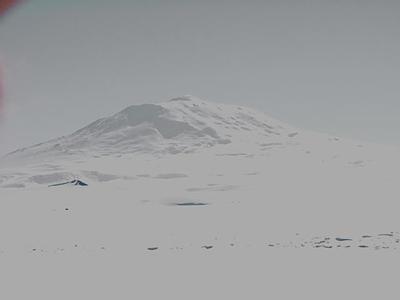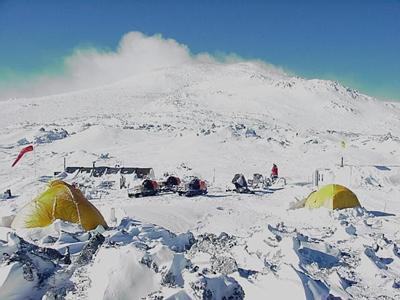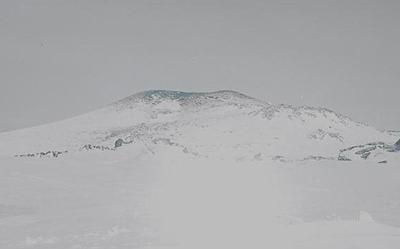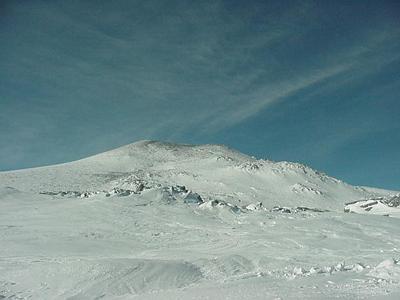3 December, 1999
Mt Erebus is a remarkable volcano with many faces. It was named by James
Ross who first sighted the mountain, Jan 27,1841. Ross named it after his
ship, the Erebus, which in Greek mythology was the “gateway to hell” It was
first climbed by the men of Ernest Shackleton’s expedition in 1908. They
used home made crampons attached to their boots made from reindeer skins.
From the ship anchored at Ross Island, they pulled a sledge with supplies
for three days up the icy slopes then abandon the sledge and hand carried
only the most essential things. That third night a storm raged and for 30
hours they lay in their sleeping bags at 2650m out in the open. Finally on
the 6th day March 10, 1908 they reached the top and looked into the
entrance to the volcano for the first time. What they saw in the crater was
steam openings hissing and belching gases. ( See journal entry Dec. 7) The
sulphur fumes were strong and below they could see a lava lake. They
hurried back to the ship by sliding down the ice using their ice axes as
brakes.
Mt Erebus is located on Ross Island at the edge of the Ross Ice Shelf. At
the base of the volcano on the Island are two science stations, one run by
Americans where we staged our efforts to get here, Mcmurdo Station. The
other run by New Zealand is around the corner, Scott Base. The well known
explorers Robert Scott and Ernest Shackleton both built huts on Ross Island
at the base of Mt Erebus, and can still be visited today.
Mt Erebus is unique in that it is one of the few volcanoes on earth with a
convecting lava lake. This means that the lake is out in the open and can
be seen to churn and cycle bringing hot lave to the surface. On the day we
visited the crater we saw several burps of lave come to the surface, as
molten lava and gas were released from the earth’s churning molten magma.
The lava is chemically unique in that it is an andesitic phonolite, as
evidence by the profusion of beautiful and rare crystals strewn about the
crater rim.
If you would like to learn more about Mt Erebus please visit the web page
which is maintained by New Mexico Institute of Technology.
<http://www.ees.nmt.edu/Geop/erebus.html>
This expedition, as well as the studies from the past 25 years, is run by
professor Dr. Philip Kyle, on faculty at New Mexico Tech. To learn more
about Dr. Kyle and his work visit his web page at:
http://www.ees.nmt.edu/faculty/kyle.html
Mt Erebus has many faces. Every morning it surprises us with a new look.
From our tents we can hear the explosions as lava is belched from the
inside the crater. Please visit this web site frequently as I will add
pictures whenever Erebus changes her mood.

Mt Erebus from afar. This is perhaps how the early explorers first saw the volcano. Here from the Ross Ice Shelf you can barely see the gas plume coming from the crater.

2. This was how the volcano appeared to us the day after our 3 day storm. With the hut in the foreground you can see how it greats us every morning. The plume you see is how it looks most days

3. Mt Erebus from another angle. On this day I took a walk to explore the area. You can see two amazing features in this picture. First the rock formations which never cease to amaze us with their form and second, if you look closely you can see some ice towers. These are also incredible structures which change form every year.

4. An overcast and sleepy day, Mt Erebus is also sleepy. The emission of gases from the crater is always the same, but on days of high humidity the plume is less evident. This was one of those days.

5. One of our glorious sunny days, the mountain is spectacular.

6. Just so you know it is true, the sun never sets here, this picture was taken at midnight. The sun is far to the right and backlights the plume for a great evening vision.

Another mood of Mt Erebus. On this day the atmosphere was full of moisture so the plume over the volcano was very evident.
Contact the TEA in the field at
.
If you cannot connect through your browser, copy the
TEA's e-mail address in the "To:" line of
your favorite e-mail package.
|
